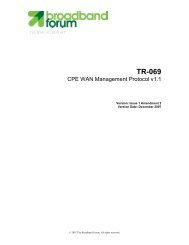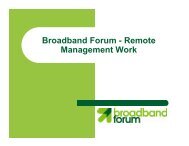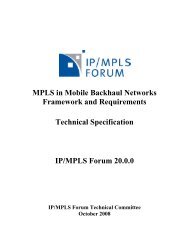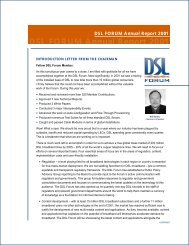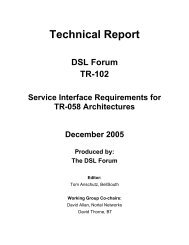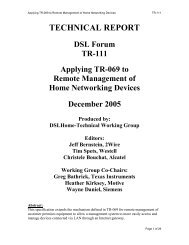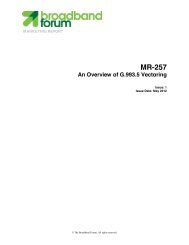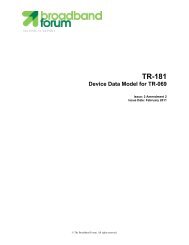Use of MPLS in Mobile Backhaul Networks - Broadband Forum
Use of MPLS in Mobile Backhaul Networks - Broadband Forum
Use of MPLS in Mobile Backhaul Networks - Broadband Forum
Create successful ePaper yourself
Turn your PDF publications into a flip-book with our unique Google optimized e-Paper software.
<strong>Use</strong> <strong>of</strong> <strong>MPLS</strong> <strong>in</strong><br />
<strong>Mobile</strong> <strong>Backhaul</strong> <strong>Networks</strong>
Introduction<br />
� <strong>Backhaul</strong> plays a vital role <strong>in</strong> mobile networks by act<strong>in</strong>g as the l<strong>in</strong>k<br />
between Radio Access Network (RAN) equipment (Eg: radio<br />
basestation) and the mobile backbone network.<br />
– This means that backhaul is able to transport mobile data from the end<br />
user to the <strong>in</strong>ternet (or similar network), mobile networks and traditional<br />
telephone networks.<br />
� The rapidly evolv<strong>in</strong>g telecoms marketplace has meant that mobile<br />
operators are fac<strong>in</strong>g a significant spike <strong>in</strong> bandwidth demands <strong>in</strong> the<br />
backhaul due to-<br />
– The proliferation <strong>of</strong> 3G-based data services and<br />
– The emergence <strong>of</strong> high-speed air <strong>in</strong>terface enhancements such as High<br />
Speed Packet Access (HSPA).<br />
� At the same time, backhaul network operators are be<strong>in</strong>g required to<br />
significantly reduce operational costs <strong>in</strong> order to compensate for<br />
decl<strong>in</strong><strong>in</strong>g Average Revenue Per <strong>Use</strong>r (ARPU) and to compete with a<br />
host <strong>of</strong> new competitors and technologies.<br />
� Operators are also required to protect (or sufficiently emulate) core<br />
legacy services such as voice, which still account for a substantial<br />
share <strong>of</strong> revenue.
Address<strong>in</strong>g the bottleneck<br />
� In this new situation backhaul networks with many cell sites<br />
have become the “bottleneck” <strong>of</strong>fer<strong>in</strong>g <strong>in</strong>sufficient capacity to<br />
support higher bandwidths and <strong>of</strong>ten expensive to upgrade.<br />
� To address the problem operators are migrat<strong>in</strong>g from exist<strong>in</strong>g<br />
separate, legacy ATM and TDM backhaul<strong>in</strong>g networks to a<br />
more cost-effective, converged, <strong>MPLS</strong>-enabled, and multipurpose<br />
<strong>in</strong>frastructure.<br />
� In addition to reduc<strong>in</strong>g operational costs, <strong>MPLS</strong>-based<br />
networks will also lay the foundations for the delivery <strong>of</strong> next<br />
generation mobile services, such as location-based services,<br />
mobile gam<strong>in</strong>g and mobile TV, and for the use <strong>of</strong> future<br />
technologies such as Long Term Evolution (LTE) and mobile<br />
WiMAX.<br />
� Ultimately, this fully consolidated network will be able to handle<br />
many different types <strong>of</strong> traffic on a s<strong>in</strong>gle cell site, enabl<strong>in</strong>g the<br />
operator to <strong>of</strong>fer many different services to many different types<br />
<strong>of</strong> customer.
<strong>MPLS</strong> <strong>Mobile</strong> <strong>Backhaul</strong> Initiative<br />
� <strong>MPLS</strong> <strong>Mobile</strong> <strong>Backhaul</strong> Initiative (MMBI) tackles<br />
these backhaul challenges.<br />
� The <strong>in</strong>itiative aims to leverage the benefits <strong>of</strong> <strong>MPLS</strong><br />
technology <strong>in</strong> the backhaul by provid<strong>in</strong>g a framework<br />
for a s<strong>in</strong>gle <strong>MPLS</strong> aggregation/backhaul network that<br />
is flexible, scalable and economical.<br />
� This presentation outl<strong>in</strong>es the market dynamics that<br />
are driv<strong>in</strong>g the need to deploy <strong>MPLS</strong> technology <strong>in</strong><br />
Radio Access Network (RAN) backhaul and provides<br />
a brief overview <strong>of</strong> the MMBI.
Market Trends
Traffic Increas<strong>in</strong>g but Revenues Shr<strong>in</strong>k<strong>in</strong>g<br />
� The comb<strong>in</strong>ation <strong>of</strong> ris<strong>in</strong>g traffic requirements coupled with decl<strong>in</strong><strong>in</strong>g<br />
revenues is a key motivation for operators migrat<strong>in</strong>g RANs to a<br />
converged, packed-based architecture<br />
� <strong>MPLS</strong> has been globally deployed <strong>in</strong> these types <strong>of</strong> networks and has<br />
been an important element <strong>in</strong> creat<strong>in</strong>g an environment for the delivery<br />
<strong>of</strong> new data services<br />
� As these packet-based networks grow <strong>in</strong> popularity, <strong>MPLS</strong> must now<br />
also be extended <strong>in</strong>to to the backhaul
Total Cell Sites & Mean Subscribers<br />
per Cell Site (2003-2013)
Market Trends & Challenges<br />
� Third-generation mobile networks have become a<br />
reality.<br />
– The total number <strong>of</strong> 3G subscribers stood at around 614<br />
Million at the end <strong>of</strong> 2007 and the number is forecasted to<br />
grow at a CAGR <strong>of</strong> 34% <strong>in</strong> near future.<br />
– Grow<strong>in</strong>g at a CAGR <strong>of</strong> over 27%, 3G market for mobile<br />
handsets will supersede 475 Million units (<strong>in</strong>clud<strong>in</strong>g HSDPA<br />
handsets) by 2010.<br />
– The grow<strong>in</strong>g 3G market is expected to fuel demand for 3Gbased<br />
<strong>Mobile</strong> TV market with subscriber growth forecasted<br />
at a CAGR <strong>of</strong> nearly 48% by 2012.<br />
– Introduction <strong>of</strong> femtocells is expected to result <strong>in</strong> mass<br />
adoption <strong>of</strong> 3G technology across the world.<br />
“3G Market Forecasts to 2010”, Market and Research 2008
Issues:<br />
Traditional <strong>Backhaul</strong>-Expensive<br />
� <strong>Mobile</strong> operators are generat<strong>in</strong>g revenues from a range <strong>of</strong> new<br />
“next generation” data services that are designed to generate<br />
revenues <strong>in</strong> addition to those from legacy voice services.<br />
� However, these new 3G-based services require a substantial<br />
<strong>in</strong>crease <strong>in</strong> bandwidth, which will <strong>in</strong> turn lead to greater mobile<br />
backhaul costs.<br />
� It is estimated that backhaul can account for as much as 30%<br />
<strong>of</strong> a mobile operator’s operat<strong>in</strong>g costs (Opex)<br />
(source: Yankee Group, 2005)<br />
� If mobile operators were to expand the backhaul network to<br />
meet these new bandwidth requirements <strong>in</strong> the traditional<br />
manner, the move to 3G could represent a significant <strong>in</strong>crease<br />
<strong>in</strong> required bandwidth and associated opex.
Issues cont.<br />
More sophisticated requirements<br />
� <strong>Backhaul</strong> needs to be able to handle a range <strong>of</strong> new<br />
functionality, <strong>in</strong>clud<strong>in</strong>g-<br />
– Quality <strong>of</strong> Service (QoS) and<br />
– Resiliency management.<br />
� These new elements will become <strong>in</strong>creas<strong>in</strong>gly<br />
important as mobile operators migrate towards<br />
packet-based backhaul networks.<br />
� <strong>Mobile</strong> backhaul networks must support many<br />
different generations <strong>of</strong> technologies simultaneously.<br />
– Must protect exist<strong>in</strong>g legacy technology <strong>in</strong>vestments for<br />
some years.<br />
– But need a backhaul strategy that is “future-pro<strong>of</strong>” and will<br />
be able to support a new generation <strong>of</strong> networks and<br />
access technologies such as LTE.
Issues cont.<br />
Access & Aggregation Diverse Traffic<br />
� The access and aggregation networks are used for more than<br />
just mobile backhaul and it <strong>in</strong>creas<strong>in</strong>gly be<strong>in</strong>g used to carry<br />
traffic for more than one mobile operator.<br />
� This requires methods <strong>of</strong> separat<strong>in</strong>g and secur<strong>in</strong>g multiple<br />
operator traffic while ma<strong>in</strong>ta<strong>in</strong><strong>in</strong>g service level agreements<br />
(SLAs).<br />
– We estimate that as many as three-quarters <strong>of</strong> 2G and 3G cell<br />
sites are co-located.<br />
� The access and aggregation networks can be used to host<br />
multiple services as well as multiple operators.<br />
� An ISP that has an IP/<strong>MPLS</strong> based network could provide<br />
services such as-<br />
– IPTV<br />
– broadband access and enterprise VPN<br />
– as well as mobile backhaul services, generat<strong>in</strong>g further value from<br />
the network.
MMBI meets the needs<br />
Flexible * Scalable * Cost Effective
<strong>Backhaul</strong> Infrastructure Requirements<br />
� The new backhaul <strong>in</strong>frastructure must therefore meet<br />
three ma<strong>in</strong> criteria; it must be-<br />
– Flexible<br />
� To support both legacy and IP services<br />
– Scalable<br />
� To support emerg<strong>in</strong>g future technologies<br />
– Cost-effective<br />
� To compensate for ris<strong>in</strong>g levels <strong>of</strong> backhaul traffic<br />
� It also needs to be a converged network, which<br />
means the operator does not need to run two<br />
separate networks (leased l<strong>in</strong>es and IP).
Overview<br />
<strong>MPLS</strong> <strong>Mobile</strong> <strong>Backhaul</strong> Initiative<br />
� In 2008, the IP/<strong>MPLS</strong> <strong>Forum</strong>, now part <strong>of</strong> the<br />
<strong>Broadband</strong> <strong>Forum</strong>, launched it’s <strong>MPLS</strong> <strong>Mobile</strong><br />
<strong>Backhaul</strong> Initiative (MMBI).<br />
� MMBI provides a framework for the use <strong>of</strong> <strong>MPLS</strong><br />
technology to br<strong>in</strong>g solutions to transport RAN<br />
backhaul traffic over access, aggregation and core<br />
networks.<br />
� The specification provides possible deployment<br />
scenarios and recommendations on how to deploy<br />
<strong>MPLS</strong> <strong>in</strong> each <strong>of</strong> these scenarios.<br />
� This is a valuable reference guide that allows<br />
vendors and operators to select the appropriate<br />
feature sets for their specific scenario.
What does MMBI address?<br />
� A shared network <strong>in</strong>frastructure that is able to support (emulate)<br />
exist<strong>in</strong>g legacy services (2G, 2.5G) as well as new services<br />
based on 3G and beyond (Eg: HSPA, LTE).<br />
– This will enable a migration path between exist<strong>in</strong>g legacy ATM and<br />
TDM backhaul networks to a more cost-effective, converged,<br />
<strong>MPLS</strong>-enabled, and multi-purpose network.<br />
� The work is <strong>in</strong>dependent from the air <strong>in</strong>terface technology<br />
wherever possible but allows for the possibility that some<br />
specific backhaul requirements related to the air <strong>in</strong>terface may<br />
need to be considered.<br />
� Areas covered:<br />
– QoS considerations (Eg; to support specific service types),<br />
– Resiliency capabilities,<br />
– Clock<strong>in</strong>g and synchronization,<br />
– Operations and Ma<strong>in</strong>tenance (OAM), and<br />
– Support for various Transport Network Layers (TNLs), LTE and<br />
mobile WiMAX.
Scope <strong>of</strong> MMBI<br />
Access<br />
Network<br />
<strong>Backhaul</strong> Transport &<br />
RAN<br />
Access<br />
Network<br />
RAN<br />
2 G<br />
3 G<br />
4 G<br />
RNC<br />
Aggregation<br />
Network<br />
Focus Area BSC<br />
for BBF<br />
backhaul a GW<br />
Transport network &<br />
<strong>Mobile</strong> Core Network<br />
Core<br />
Network<br />
2G SGSN<br />
3G PDSN/<br />
SGSN<br />
3G MSC<br />
2G MSC<br />
PSN<br />
Internet<br />
GGSN<br />
PDN GW<br />
CSN WiMAX
Bus<strong>in</strong>ess Benefits<br />
� MMBI will directly impact mobile operators’ bottom l<strong>in</strong>e by-<br />
– Simplify<strong>in</strong>g operations,<br />
– Reduc<strong>in</strong>g Operat<strong>in</strong>g Expenses (OPEX)<br />
– Leverag<strong>in</strong>g the cost benefits <strong>of</strong> backhaul technologies such as Ethernet.<br />
– Enabl<strong>in</strong>g operators to support “next generation” services such as locationbased<br />
services (LBS), mobile IPTV and mobile gam<strong>in</strong>g, and<br />
– Provid<strong>in</strong>g flexibility to protect <strong>in</strong>vestments <strong>in</strong> new and emerg<strong>in</strong>g<br />
technologies.<br />
� This flexibility works <strong>in</strong> two ways:<br />
– it will protect radio equipment <strong>in</strong>vestment legacy 2G/3G and<br />
– It will be able to be re-used aga<strong>in</strong> as mobile operators migrate to future<br />
technologies such as LTE and mobile WiMAX.<br />
� <strong>MPLS</strong> is an established technology with proven track record for<br />
provid<strong>in</strong>g-<br />
– QoS,<br />
– traffic eng<strong>in</strong>eer<strong>in</strong>g (TE),<br />
– legacy layer 1 and layer 2 emulation (via pseudowires) and<br />
– resiliency features.<br />
� These advantages can be leveraged for use <strong>in</strong> a wide variety <strong>of</strong><br />
network architectures and applications such as Enterprise VPN, IPTV,<br />
mobile backhaul among others.
Why is MMBI uniquely qualified as the<br />
<strong>Backhaul</strong> solution?<br />
� Amaz<strong>in</strong>g flexibility<br />
– Supports both legacy mobile backhaul networks as well as future<br />
technologies such as LTE.<br />
� For example, the same <strong>MPLS</strong> network <strong>in</strong>frastructure can be used to carry the<br />
legacy traffic pseudowires, may also be used to carry and provide QoS<br />
guarantees to next generation LTE traffic.<br />
� Investments <strong>in</strong> <strong>MPLS</strong> technologies benefit the service provider by mak<strong>in</strong>g it<br />
“future pro<strong>of</strong>” and still applicable <strong>in</strong> the fast evolv<strong>in</strong>g mobile technology scenarios<br />
(eg: LTE and beyond).<br />
– Deploys on any layer 2 technology capable <strong>of</strong> support<strong>in</strong>g <strong>MPLS</strong> labeled<br />
switch<strong>in</strong>g.<br />
– Ideally suited to overcome the scalability limitations <strong>of</strong> traditional circuit<br />
based technologies such as ATM and TDM.<br />
� <strong>MPLS</strong> permits support <strong>of</strong> these technologies us<strong>in</strong>g pseudowires to protect<br />
exist<strong>in</strong>g <strong>in</strong>vestments <strong>in</strong> legacy equipment. For future IP and Ethernet based<br />
<strong>in</strong>terfaces, it is possible to aggregate traffic over s<strong>in</strong>gle TE tunnels and provide<br />
differentiated services for this aggregate so that QoS requirements are met while<br />
at the same time provid<strong>in</strong>g further improvements <strong>in</strong> scalability.<br />
– Provides economies <strong>of</strong> scale.<br />
� Leverages the <strong>MPLS</strong> network to meet the requirements <strong>of</strong> not only the diverse<br />
set <strong>of</strong> mobile backhaul technologies but also to those <strong>of</strong> other applications, the<br />
<strong>MPLS</strong> network also.<br />
� This provides significant reduction <strong>of</strong> capital and operational costs.
Architectural Scenarios<br />
EDGE (2.5G)<br />
Network<br />
GSM/GPRS (2G/2.5G)<br />
UMTS /HSDPA/HSUPA<br />
(3G)<br />
CDMA 1x-RTT (2.5G)<br />
CDMA 1x EV-DO (3G)<br />
<strong>Mobile</strong> WiMAX<br />
Long Term Evolution (4G)<br />
R3, R99/R4<br />
R99/R5, R6<br />
IS-2000<br />
IS-856<br />
WiMAX <strong>Forum</strong> Network<br />
Access Architecture R1.1<br />
R7/R8<br />
Specification<br />
Transport Network<br />
Layers (TNLs)<br />
TDM<br />
TDM<br />
ATM<br />
ATM<br />
IP<br />
HDLC or TDM<br />
IP<br />
IP<br />
IP<br />
Speed (approximate)<br />
56 - 114 Kbps<br />
236.8 Kbps – 473.6<br />
Kbps<br />
~384 Kbps (upl<strong>in</strong>k) ~ 2<br />
to 3.1 Mbps (downl<strong>in</strong>k)<br />
144 Kbps)<br />
~ 1.8 Mbps (upl<strong>in</strong>k), ~<br />
3.1 Mbps (downl<strong>in</strong>k)<br />
50 Mbps<br />
> 50 Mbps (upl<strong>in</strong>k)<br />
> 100 Mbps (downl<strong>in</strong>k
Architectural Overview<br />
� Network architectures for RAN backhaul <strong>in</strong><br />
the IP/<strong>MPLS</strong> <strong>Forum</strong>’s <strong>MPLS</strong> <strong>Mobile</strong> <strong>Backhaul</strong><br />
Initiative are def<strong>in</strong>ed for various Transport<br />
Network Layers (TNL) and mobile network<br />
generations.<br />
� These scenarios are grouped as follows and<br />
comprise two basic categories:<br />
– Legacy (TDM, ATM, HDLC) and<br />
– Future (IP/Ethernet).
Legacy Options<br />
� In the legacy environment, RAN equipment-<br />
– Communicates via either TDM or ATM TNLs and<br />
– Are connected with a T1/E1 <strong>in</strong>terface, or with an<br />
Ethernet <strong>in</strong>terface (Fast Ethernet) if TDM or ATM<br />
is encapsulated over Ethernet via IP or <strong>MPLS</strong>.<br />
– The functionality necessary to transport legacy<br />
traffic over <strong>MPLS</strong> can be performed either at the<br />
edge node, the access node, the access gateway<br />
or directly <strong>in</strong> the RAN equipment.<br />
– The HDLC layer features <strong>in</strong> CDMA 1x-RTT and<br />
covers RAN equipment communicat<strong>in</strong>g by means<br />
<strong>of</strong> HDLC-encoded bit streams.
IP/Ethernet Options<br />
� IP/Ethernet scenarios <strong>in</strong>clude:<br />
– In R5 3G, LTE and mobile WiMAX environments, the RAN<br />
equipment <strong>in</strong>terfaces use the IP TNL – either at the Iub<br />
<strong>in</strong>ter-face (for 3G) or on R7/R8 for LTE or mobile WIMAX.<br />
– <strong>Mobile</strong> traffic over IP TNL can be transported either via<br />
Ethernet pseudowires or regular IP/<strong>MPLS</strong> TE tunnels over<br />
MMBI’s mobile backhaul network.<br />
– IP term<strong>in</strong>ation can take place either at the edge node, the<br />
access node, the access gateway or directly at the RAN<br />
equipment.<br />
� Various deployment scenarios arise depend<strong>in</strong>g on<br />
the location (and the extent) <strong>of</strong> <strong>MPLS</strong> technology <strong>in</strong><br />
the mobile backhaul network and whether it<br />
comprises both the access and aggregation sections<br />
<strong>of</strong> the network or just the aggregation section.
RAN Equipment Synchronization<br />
� RAN equipment needs to be fully synchronized to a common<br />
reference tim<strong>in</strong>g signal to ensure-<br />
– sufficient frequency stability,<br />
– radio fram<strong>in</strong>g accuracy and<br />
– hand<strong>of</strong>f control for RF channels.<br />
� Thus the mobile backhaul network needs to support distribution<br />
<strong>of</strong> frequency from the Radio Network Controller (RNC) to the<br />
RAN equipment.<br />
– Example: <strong>in</strong> the case where the air-<strong>in</strong>terface is based on Time<br />
Division Duplex<strong>in</strong>g (TDD), the base station clocks must be<br />
synchronized to ensure no overlap <strong>of</strong> their transmissions with<strong>in</strong> the<br />
TDD frames.<br />
� Ensur<strong>in</strong>g synchronization allows for tighter accuracies and<br />
reduced guard bands thereby ensur<strong>in</strong>g higher capacity.
Clock<strong>in</strong>g and Sync <strong>in</strong> RAN<br />
1: Radio Fram<strong>in</strong>g<br />
Accuracy<br />
BTS<br />
BTS<br />
NodeB<br />
NodeB<br />
BSC<br />
BSC<br />
RNC<br />
2 : Hand<strong>of</strong>f<br />
Control 3 : <strong>Backhaul</strong><br />
Transport Reliability<br />
<strong>Mobile</strong> Core<br />
Network(s)<br />
� Synchronization is vital across many elements <strong>in</strong> the mobile<br />
network<br />
� In the Radio Access Network (RAN), the need is focused <strong>in</strong> three<br />
pr<strong>in</strong>cipal areas
How does MMBI Address Tim<strong>in</strong>g?<br />
� The MMBI outl<strong>in</strong>es the follow<strong>in</strong>g methods for clock distribution<br />
over an IP/<strong>MPLS</strong> based backhaul network.<br />
– In RAN equipment with IP TNL (<strong>in</strong>clud<strong>in</strong>g LTE)<br />
� Packet based methods where the frequency reference is carried over<br />
packets (e.g., based on Network Time Protocol (NTP)) may be used to<br />
deliver frequency to address the frequency stability requirements <strong>of</strong><br />
the radio equipment.<br />
– For legacy TNLs, such as TDM and ATM<br />
� Dedicated tim<strong>in</strong>g stream implemented us<strong>in</strong>g a pseudowire may be<br />
used to carry the reference tim<strong>in</strong>g signal from the RNCs to the RAN<br />
equipment both for backhaul transport reliability as well as frequency<br />
stability requirements <strong>of</strong> the radio equipment<br />
� Other methods for distribut<strong>in</strong>g the reference tim<strong>in</strong>g signal to the<br />
RAN equipment <strong>in</strong>clude:<br />
– Synchronous Ethernet or IEEE 1588 v2<br />
– PDH/SDH transmission mechanisms used <strong>in</strong> the mobile access<br />
networks.<br />
– GPS is also widely used to support the strict synchronization<br />
requirements <strong>of</strong> TDD systems
OAM & Resiliency<br />
� A key advantages <strong>of</strong> <strong>MPLS</strong> is that it provides a wide selection<br />
<strong>of</strong> flexible troubleshoot<strong>in</strong>g and OAM tools that enable the<br />
deployment <strong>of</strong> a truly carrier-grade backhaul network.<br />
� These <strong>in</strong>clude-<br />
– Fault detection methods to drive protection switch<strong>in</strong>g mechanisms<br />
such as <strong>MPLS</strong> Fast Reroute.<br />
– Fault diagnosis, fault isolation (eg: LSP P<strong>in</strong>g and LSP traceroute)<br />
and performance monitor<strong>in</strong>g.<br />
– Loopback and connectivity check.<br />
� Examples <strong>in</strong>clude VCCV for pseudowire-based <strong>MPLS</strong> backhaul<br />
solutions and BFD for IP based <strong>MPLS</strong> backhaul solutions.<br />
� These OAM tools will rema<strong>in</strong> applicable for future LTE mobile<br />
backhaul networks implemented as either IP based or Ethernet<br />
pseudowire based solutions.<br />
– Note: For legacy TNLs and Ethernet pseudowire based solutions,<br />
the MMBI <strong>in</strong>itiative leverages previous specifications by the<br />
IP/<strong>MPLS</strong> <strong>Forum</strong> that support <strong>in</strong>terwork<strong>in</strong>g between native<br />
Layer1/Layer2 OAM and <strong>MPLS</strong> OAM.
Conclusion<br />
� <strong>MPLS</strong> technology <strong>in</strong> backhaul is the solution to the bottleneck <strong>in</strong> today’s<br />
mobile network.<br />
– Offers benefits and cost efficiencies <strong>in</strong> both legacy mobile backhaul and for<br />
future environments based on new technologies such as LTE.<br />
– Protects exist<strong>in</strong>g technology <strong>in</strong>vestments<br />
– Ensures that the technology will rema<strong>in</strong> sufficiently “future pro<strong>of</strong>” and<br />
scalable.<br />
– New services can be successfully rolled out, while mobile operators are able<br />
to leverage further cost benefits by us<strong>in</strong>g an <strong>MPLS</strong>-based backhaul network<br />
to deliver many non-backhaul services.<br />
� MMBI provides guidel<strong>in</strong>es on the architecture, scenarios and technology<br />
choices for IP/<strong>MPLS</strong> RAN backhaul with<strong>in</strong> the various network<br />
environments (legacy, IP, converged).<br />
– The MMBI framework is based on the mobile network def<strong>in</strong>itions outl<strong>in</strong>ed by<br />
the <strong>in</strong>dustry standards organizations (3GPP, 3GPP2, WiMAX <strong>Forum</strong> etc.)<br />
– The solution is based on <strong>MPLS</strong> specifications and protocols developed at the<br />
IETF.<br />
– The MMBI <strong>in</strong>itiative is also be<strong>in</strong>g coord<strong>in</strong>ated with other mobile backhaul<br />
activities underway at <strong>in</strong>dustry organizations such as the Metro Ethernet<br />
<strong>Forum</strong> (MEF).
For more <strong>in</strong>formation<br />
Check out<br />
http://www.broadband-forum.org/technical/ipmplstechspec.php



